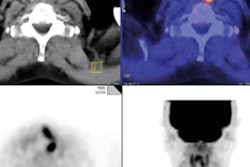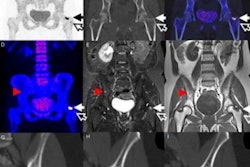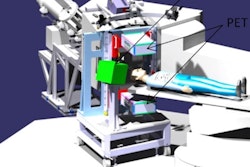
A hybrid multiplexing technique can help to facilitate a clinical-scale PET scanner based on silicon photomultipliers (SiPMs), according to researchers.
SiPMs have been proposed as a way to replace conventional photomultiplier tubes in PET scanners for over a decade. Attractive characteristics include high temporal resolution and insensitivity to magnetic fields, which could enable superior time-of-flight (TOF) and hybrid PET/MRI systems, respectively. However, a push toward longer scanners to increase sensitivity presents a stiff engineering challenge, requiring the processing of signals from thousands of tightly packed detectors in limited space.
"Signal multiplexing techniques that manage such large numbers of output channels from the SiPM-based PET detectors with minimum performance degradation is a critical technology in the development of future PET scanners," said Jae Sung Lee, PhD, head of the Functional & Molecular Imaging System Lab at Seoul National University (SNU) in South Korea.
 Researchers from the Functional & Molecular Imaging System Lab at Seoul National University.
Researchers from the Functional & Molecular Imaging System Lab at Seoul National University.In new work, Lee and co-authors Haewook Park and Guen Bae Ko developed a multiplexing technique that could enable a clinical-scale PET scanner based on SiPMs, a longer-term goal of Lee's lab. Simplified time-based readout electronics that do not require an analog-to-digital converter were combined with the technique, which is a hybrid of two established multiplexing approaches -- resistive charge division and capacitive charge division (Physics in Medicine and Biology, 5 May 2017, Vol. 62:11, pp. 4390-4405).
Resistive charge division uses a network of resistors with PET detector outputs connected at specific nodes. The four outputs of the network encode the detector's location. When combined with SiPMs, however, a low-pass filter results that distorts the scintillation pulses, degrading the timing resolution.
"The slow response increases the uncertainty of pickup time of incoming gamma ray photons," Park explained. "Thus, it is important to minimize the resistive component in the multiplexing network to achieve faster timing performance of the PET detector."
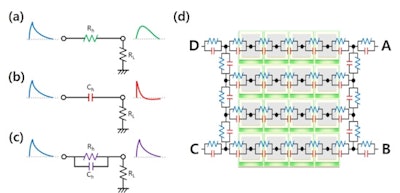 The SNU group developed a hybrid multiplexing approach that replaces the resistors used in resistive charge division (a) and the capacitors in capacitive charge division (b) with a resistor and capacitor in parallel (c). The combination avoids the degradation in SiPM timing resolution seen in (a) and energy resolution in (b). The full hybrid scheme is shown in (d).
The SNU group developed a hybrid multiplexing approach that replaces the resistors used in resistive charge division (a) and the capacitors in capacitive charge division (b) with a resistor and capacitor in parallel (c). The combination avoids the degradation in SiPM timing resolution seen in (a) and energy resolution in (b). The full hybrid scheme is shown in (d).The second approach replaces the resistors with capacitors. Here, however, the capacitance creates a high-pass filter, distorting the scintillation pulse tail into a negative "undershoot" that degrades the detectors' energy resolution. In a bid to sidestep the limitations of the two approaches, the researchers replaced the individual resistors and capacitors with pairs of parallel resistors and capacitors.
Performance testing
Performance of the hybrid multiplexing was compared with the resistive and capacitive techniques, trialing them with two SiPM-scintillation crystal configurations: a 4 x 4 SiPM array, coupled one-to-one with a 4 x 4 LGSO crystal block and in a light-sharing arrangement with a 9 x 9 LYSO crystal array. The combinations were paired with a photomultiplier tube as a reference detector for coincidence detection and flood- irradiated with a sodium-22 source.
Time-over-threshold (ToT) read-out electronics were applied to each multiplexing network. The technique estimates gamma photon energy based on an assumption of uniformly-shaped pulses across all detectors in a given array. When this is the case, the time the detector signal exceeds a fixed threshold correlates with the cumulative charge of the signal, a measure of photon energy. To date, the technique was thought to be unfeasible using charge division multiplexing due to the pulse nonuniformity produced by conventional approaches.
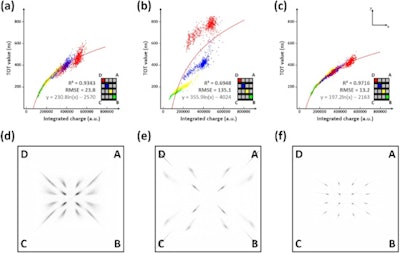 Uniform pulses produced across the detector array resulted in a high correlation between time-over-threshold (ToT) and the integrated charge per pulse, indicating the ToT technique's feasibility ((a) resistive, (b) capacitive, and (c) hybrid circuits). Flood histograms generated with the ToT readout demonstrated that distortions of the crystal map produced by the resistive (d) and capacitive (e) networks were markedly mitigated using the hybrid network (f).
Uniform pulses produced across the detector array resulted in a high correlation between time-over-threshold (ToT) and the integrated charge per pulse, indicating the ToT technique's feasibility ((a) resistive, (b) capacitive, and (c) hybrid circuits). Flood histograms generated with the ToT readout demonstrated that distortions of the crystal map produced by the resistive (d) and capacitive (e) networks were markedly mitigated using the hybrid network (f).The measurements revealed the hybrid network had good energy and time resolution. The one-to-one SiPM-crystal configuration, for example, had an energy resolution of 10.7 ± 0.5% and a coincidence resolving time (CRT) of 388 ± 17 ps in the one-to-one crystal-SiPM coupling. The network inherited the timing resolution of the capacitive network, while energy resolution in the three networks was comparable.
The hybrid network also produced uniformly-shaped pulses across all detectors compared with the other two networks. It resulted in the highest correlation between ToT and integrated charge, corresponding to superior energy estimation capabilities and making the ToT readout a feasible option.
"The combination of hybrid multiplexing and time-based readout approaches is a great choice for simplifying the PET readout electronics with minimal system performance degradation," Ko commented on the findings.
In ongoing work, the researchers are investigating the potential of the hybrid technique applied to an array of 64 SiPMs, up from the 16 tested in the current study. In the near future, they also plan to begin work to incorporate the technique into an investigative, clinical scale PET scanner.
© IOP Publishing Limited. Republished with permission from medicalphysicsweb, a community website covering fundamental research and emerging technologies in medical imaging and radiation therapy.




